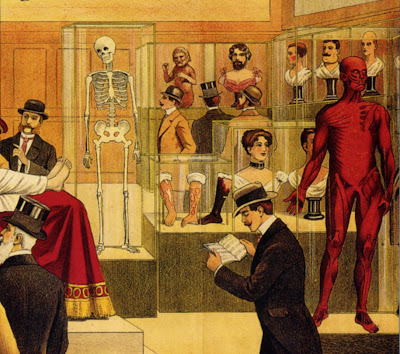Why do we visit anatomical museums: for curiosity or for learning? (or maybe for some other reason?)
Next Friday, 17 December, Elena Corradini at the Università di Modena e Reggio Emilia organises a seminar on “Visiting an Anatomical Museum: curiosity or training?”:
Anatomical University Museums are the keepers of collections which often are very old and different for their consistence and typology. These museums have a fundamental role for the preservation and valorization of cultural historical‐scientific heritage, therefore must become a place of interdisciplinary synthesis. They represent the progress of studies in the past and for the future, and play their fundamental role for the research and for the promotion of educational activities. This role will allow them to be a service for University students and professors, and to spread scientific knowledge to different audiences. Developing the capacity of museums to work in a network is necessary for them to become centres for the production of knowledge, activities and services.
Speakers include a number of directors and curators from Italian university anatomical museums together with the directors of the Josephinum of Vienna and the Museum of Medical University of Danzig:
- Giovanni Mazzotti, University of Bologna: Visiting an Anatomical Museum: curiosity or training?
- Sonia Horn, University of Wien: The growth of collections for the permanence of an historical Anatomical Museum. The case of the Josephinum in Vienna.
- Roberto Toni, University of Parma: The Anatomical Museum as a research source in the field of
biomedical robotics: the Tenchini project at the University of Parma - Alessandro Ruggeri, Nicolò Nicoli Aldini, Stefano Durante, Vittorio Delfino Pesce, University of Bologna: The visit of the Anatomical Waxes Museum “Luigi Cattaneo” center of in-depth research of the Bolognese medical tradition of XIXth century and of training for modern education
- Ugo Pastorino, National Tumour Institute, Milan: The project for a virtual archive of human body images
- Carla Garbarino, University of Pavia: The anatomical collections of the Museum for the history of the University
- Marek Bukowski, University of Gdansk: An Anatomical collection and Museum of Medical University
- Berenice Cavarra, University of Modena and Reggio Emilia: Medicine and the study of the living being in XVIIth and XVIIIth centuries
- Vincenzo Esposito, Second University of Neaples: Anatomical Museums between past historical identity and present cultural crossbreeding
- Marina Cimino, University of Padua: The birth in a museum or the birth of a museum: the obstetric collection in Padua
- Elena Corradini, Elisa Orlando, Daniela Nasi, Silvia Rossi, Sara Uboldi, University of Modena and Reggio Emilia: POMUI ‐ The Portal of Italian University Museums
- Giorgio Bonsanti, University of Florence; Elena Corradini, Berenice Cavarra, University of Modena and Reggio Emilia; Paolo Nadalini, INP, Institut National du Patrimoine, Paris; Luigi Vigna, Opificio delle Pietre Dure, Florence; Isabelle Pradier, INP, Institut National du Patrimoine, Paris: A project for the restoration of anatomical waxes
Info from Silvia Rossi or Sara Uboldi, University of Modena and Reggio Emilia (silvia.rossi@unimore.it; sarauboldi@yahoo.it), +39 059 205 5012
(thanks to Sébastien Soubiran for the tip)


 The theme of the 6th annual conference in the ‘Science and the Public’ series, to be held at Kingston University, London, on 2-3 July 2011, is ‘A Quarter Century of PUS: Retrospect and Prospect.’
The theme of the 6th annual conference in the ‘Science and the Public’ series, to be held at Kingston University, London, on 2-3 July 2011, is ‘A Quarter Century of PUS: Retrospect and Prospect.’